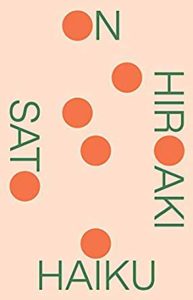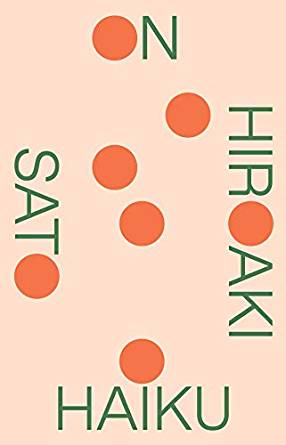Review by Robert MacLean
For the last five decades, Hiroaki Sato has been an eminent translator of Japanese poetry, translating over three dozen books into English, including a just-published anthology of haiku written by victims of the 2011 tsunami and earthquake. Born in Taiwan in 1942, his family moved to Kyushu after the war, and he studied at Doshisha University in Kyoto before moving to the US in 1968, basing himself in New York City. His landmark anthology From the Country of Eight Islands (1981), coedited with Burton Watson, has been an inspiration to many. I still vividly remember camping in the Olympic Mountains in Washington State, reading these poems in an alpine meadow amid melting snow, entranced, as if remembering past lives. Looking up, poems drifted in the endless sky.
New Directions released Sato’s On Haiku (2018), a collection of nineteen essays, some previously published in obscure journals or given in presentations. It has many strengths. Simply as a cornucopia of haiku, often from writers unknown in the West, it is a treasure. Each Japanese haiku is given in kanji, a transliteration into romaji, and Sato’s rendition, using monolinear form. Rather than tailor the original text to an English-speaking audience, his instinct is to trust the literal image with its myriad connotations, then provide illuminating commentary on the linguistic and cultural nuances. An accomplished poet himself, Sato speaks from the inside, giving a hand’s-on perspective. His explication of individual haiku is never dryly academic, but delightfully discursive, opening the poems in a way that touches our daily lives.
The essays cover a wide range of topics, from the roots of haiku in the Edo period as a hokku, “opening verse” in sequential renga, “linked verse” composed collaboratively in a guest-host relationship, to contemporary gendai, experimental forms which subvert the rules. Along the way, separate sections consider haiku and Zen; a close analysis of a single renga with thirty-six segments, ‘The Sea Darkens’, led by Matsuo Basho in a 1684 session with local participants; parallels between Issa and Hokusai in their use of perspective; military haiku; ‘From Wooden Clogs to the Swimsuit: Women in Haikai and Haiku’, spanning two centuries; and introductions to the work of many 20th-century Japanese haijin (haiku writers), particularly women.
‘Haiku and Zen: Association and Dissociation’ examines the contentious issue concerning the extent to which haiku is infused with Zen. Drawing on ancient Chinese Chan koans, it is a comprehensive survey that includes Basho’s famous frog, Jack Kerouac, Gary Snyder, American Zen and Japanese practitioners such as Kōi Nagata who, Sato points out, modelled some of his haiku upon the life and work of the medieval monk, Master Ikkyū:
Gaikotsu ga namaeau aki mo nagori kana
Skeletons licking each other as autumn lingers
Two essays packed with historical detail track haiku during Japan’s war with China, followed by the Asia-Pacific conflicts. Shinzunojo Takeshita, a teacher and librarian, writes in 1937 about her son:
Yuku ako ni getsumei no nasu mugi kashigu
For my child going to war I pick and cook moonlit eggplants
Hiroshi Shimomura, a doctor, in the aftermath of the Nagasaki blast:
Enten no mukuro o hakobu jinkaisha
Carrying cadavers under burning sky a garbage cart
One of the strongest dimensions of Sato’s book is its introduction to the work of many twentieth century women haijin. ‘From Wooden Clogs to the Swimsuit: Women in Haikai and Haiku’ spans four centuries. Chiyojo Kaga, a contemporary of Bashō, writes about the loss of her child:
Tombo-tsuri kyō wa koko mada itta yara
Dragon-catcher, how far has he gone today?
Takao Hashimoto in 1937, nursing her husband who died that autumn:
Shi ni chikaki mo ni yori tsuki no teru o iinu
Up close to his face near death I said the moon’s shining
A decade later, she still misses him deeply:
Yuki hageshi dakarete iki no tsumarishi koto
Snow fierce how hugged I was breathless
The essay ‘Haiku Poet Called a Hooker’ focuses on Shizuko Suzuki, who lived with an African American soldier after WWII and abruptly disappeared, probably of suicide, leaving over 7,000 unabashedly sensual haiku dealing with taboo topics including prostitution, drug addiction and abortion:
Suki no mono wa ruri bara ame eki yubi shunrai
What I like crystal roses rains stations fingers spring thunder
‘In the Cancer Ward’ introduces Chimako Tada, a respected translator. She took up haiku only when diagnosed with cervical cancer, as a form of therapy encouraged by her daughter. After her death in 2003, one hundred and sixty of her haiku were published. Some two dozen are included in the book.
Natsuyase ya sukoshi fuetaru shi no omomi
Summer-thin: a little gaining the weight of death
and,
Kusa no se o noritsugu kaze no yukue kana
Riding from one blade of grass to another the wind goes where
On Haiku is filled with such jagged beauty. Throughout, what Sato calls his “meandering discourse” is wonderfully erudite, playful and profound. It ends with two poignant personal essays, ‘Receiving a Falconer’s Haibun’ and ‘Through the Looking Glass’, admitting the problematic relationship of translator to text, which invariably results in a variant of failure–each failure precious, a facet or shard of the original which itself engages in the same process. Again and again, Sato reveals how the radical brevity of the haiku genre contains worlds within worlds. This is a book to cherish, which nurtures in return.


